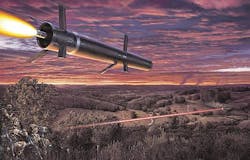Optical warfare just took a big step toward reality with award of Navy CESARS contracts
The latest developments revolve around a U.S. Navy research program called Combined EO/IR Surveillance and Response System -- or CESARS for short. This initiative seeks to develop an electro-optical shipboard defense system to protect surface warships from missiles, fast attack boats, unmanned aerial vehicles (UAVs), and other optically guided threats.
The CESARS program has two parts, and research contractors are lined up for both of them. We'll know by the end of this decade how promising the enabling technologies those contractors are developing will be.
The first part of the CESARS program is the Shipboard Panoramic EO/IR Cueing and Surveillance System -- better-known as SPECSS -- while the other part is the Multispectral EO/IR Countermeasures for Advanced Threats project, or MEIRCAT.
L-3 Cincinnati Electronics in Mason, Ohio, won a $9 million contract in early February to develop the SPECSS portion of the CESARS program, while the Lockheed Martin Laser and Sensor Systems segment in Bothell, Wash., (formerly Aculight) won a $10.6 million contract earlier this month to develop MEIRCAT.
Together, SPECSS and MEIRCAT are expected to develop core enabling technologies for comprehensive shipboard defenses against optically guided threats.
For SPECSS, L-3 Cincinnati Electronics engineers are developing an enhanced electro-optical and infrared (EO/IR) countermeasure and situational awareness capability that performs wide field-of-view target detection and tracking and then cues MEIRCAT high-resolution sensors.
For MEIRCAT, meanwhile, Lockheed Martin is developing capabilities for target re-acquisition, tracking, classification, identification, 3-D ranging, threat assessment, countermeasures execution, and countermeasures effectiveness monitoring (CMEM). MEIRCAT also will offer multi-band capability against many different fast incoming targets during the same engagement.
Shipboard defenses that work at the speed of light: perhaps those will come in handy as U.S. adversaries develop hypersonic anti-ship missiles that streak through the air at speeds approaching eight times the speed of sound.
Even more intriguing than the quantum leap in shipboard defenses that SPECSS and MEIRCAT might offer is the prospect of how these and other optical warfare technologies might evolve in the future. More to the point, I'm thinking about how the mature principles of electronic warfare (EW) might apply to the emerging principles of optical warfare.
Electronic warfare pertains to the radio-frequency (RF) spectrum, and involves offensive and defensive military operations that emit or receive RF energy. It seeks to enable the use of RF sensors like radar and RF communications like radios, while denying any enemy the use of RF systems through electronic jamming, eavesdropping, or special missiles that home-in on radar and communications signals.
Now let's apply that to optical warfare. It would follow that optical warfare pertains to the optical spectrum, and involves offensive and defensive military operations that emit or receive optical energy. Optical warfare seeks to enable the use of optical sensors like visible-light and infrared cameras, infrared guidance systems, and laser range finders, while denying the enemy use of optical systems through optical jamming, eavesdropping on laser and other optical communications, or special missiles that home-in on visible-light or infrared guidance systems.
Now look at the CESARS programs and its components. SPECSS is developing an EO/IR countermeasure (jammer), as well as target detection, tracking, and sensor cueing. MEIRCAT is developing EO/IR target tracking and ranging, countermeasures execution (jammers or anti-optical weapons), and countermeasures effectiveness monitoring (weapons damage assessment). Sounds an awful lot like what we expect from EW, except in the optical spectrum.
We have electronic warfare systems today -- the HARM missile comes to mind -- that are designed to detect, locate, and attack RF emitters. How long will it take to develop optical warfare systems that detect, locate, and attack optical sensors and emitters? From the sound of it, this won't take long.
It's likely that very soon the notion of optical warfare won't simply be a matter of conjecture.

